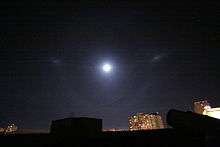Moon dog
This article is about the optical phenomenon. For other uses, see Moondog (disambiguation).

A halo around the Moon and a pair of moon dogs over the observatory at the University of Alberta in Edmonton, Canada.
A moon dog, moondog, or mock moon,[1] (scientific name paraselene,[1] plural paraselenae, meaning "beside the moon") is a relatively rare bright circular spot on a lunar halo caused by the refraction of moonlight by hexagonal-plate-shaped ice crystals in cirrus or cirrostratus clouds.[2]
Moon dogs appear as part of the 22° halo, roughly 10 Moon diameters outside the Moon.[3] They are exactly analogous to sun dogs, but are rarer because the Moon must be bright, about quarter moon or more, for the moon dogs to be observed. Moon dogs show little color to the unaided human eye because their light is not bright enough to activate the cone cells.
See also
References
- 1 2 "Definition of paraselene". Collins English Dictionary.
- ↑ Lisle, Jason. The Stargazer's Guide to the Night Sky. p. 83.
- ↑ Lisle, Jason. The Stargazer's Guide to the Night Sky. p. 83.
This article is issued from Wikipedia - version of the 4/1/2016. The text is available under the Creative Commons Attribution/Share Alike but additional terms may apply for the media files.